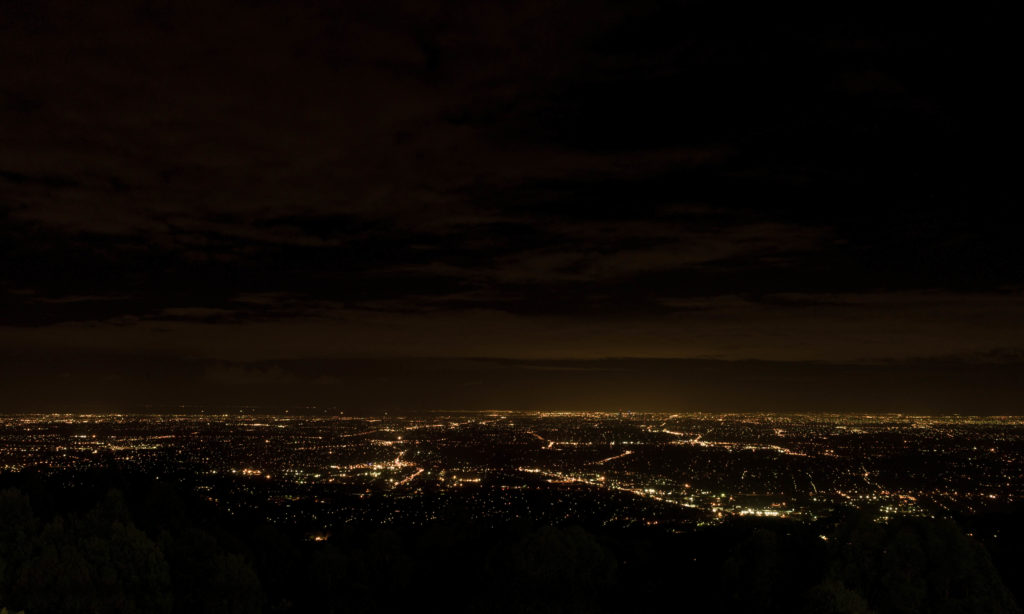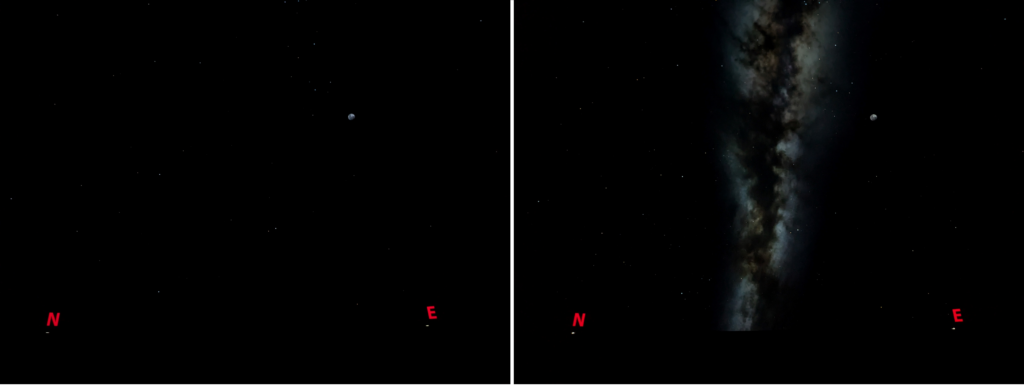Blinded by the Lights: The Impacts of Light Pollution
By Dr Catriona Nguyen-Robertson MRSV
Senior Editor, Science Victoria
In what should be the darkest hours of night, urban landscapes are increasingly illuminated. The stars, once clear and bright, are hidden amongst the glow of artificial light.

We have so many lights on at night: lights on in our homes, lamps on our streets, and blazing signs scattered through the city. This is light pollution, and it disrupts the natural rhythms of animals, and leads astray those who use the stars and Moon to navigate.
We need to return to darker skies – skies without the hazy “sky glow” created by artificial lights.
Drowning light from the stars
Have you ever seen the Milky Way from Melbourne city?
The artificial sky glow is so bright that it overpowers light emitted by stars far away. Only in “dark skies”, away from the bright lights of cities, can you see the Milky Way arcing across the sky, made of billions of distant stars and vast interstellar dust clouds.
More than 80% of the world’s population does not have access to dark skies, and more than a third have never seen the Milky Way with their own eyes.1
In Melbourne, only a couple of hundred individual stars are visible to the naked eye. But away from the bright lights of the city (or if you were in Melbourne 200 years ago), you can see over 2,000.2
For many cultures, a sky filled with stars (including the Sun), the Moon, planets, and meteorites, is considered a part of the natural environment – just as important as the land below.
Careful observations of the night sky over millennia are embedded within the traditions and cultures of First Peoples. They create meaning in the sky above that guides them in life on the ground below, as the knowledge is tied in with seasonality, animals, plants, weather, navigation, and values. But will these stories and this knowledge persist if the stars can no longer be seen?
The shadows of light pollution on wildlife
The glow of urban landscapes intrudes upon the natural world – far beyond the last light street light.
We know that artificial light at night can disrupt our sleep – imagine if your neighbours’ lights glared into your bedroom every night as you try to sleep. In addition to this nuisance, artificial light has quantifiable negative effects on human health. When exposed to even dim lights, we sleep for less time and less deeply, increasing risks for sleep disturbances and chronic conditions.3
Understandably, it also impacts animals. We are being that neighbour to our local fauna. Wildlife relies on natural light for their patterns of rest and activity, their growth and reproduction, and navigation.

Artificial light masks day length and other natural light cues used by animals to regulate their daily activity and annual reproduction. For nocturnal species, the night is a time of activity, a crucial part of their daily rhythm. But under the relentless glare of urban light pollution, their behaviours change and their instincts falter. Native mammals are most active in low light conditions (at night, dusk, and dawn). Brightly lit areas expose them to predators, including daytime predators that can now better hunt at night. Even for herbivores, light pollution can reduce food availability by altering the timing of plant reproduction, flowering, and fruiting.4
Animals that rely on dark skies for navigation are losing their way. After hatching on the beach, turtle hatchlings crawl towards the brightest direction, which should be light from the night sky reflected on the ocean.4 But lights from on-shore confuse them, causing them to travel away from the water or crawl in circles.
The sky glow also prevents fledgling seabirds from taking their first flight, as they only fly under the cover of darkness.4 Dung beetles, the first known species to navigate using the Milky Way,5 are losing their guide the more it becomes washed out. Bogong moths that travel to and from the Australian Alpine Region are being drawn to the light of cities – and this impacts mountain pygmy-possums that rely on the moths making the trip to have food.6
All species in an ecological community rely on each other, and so artificial light doesn’t just impact isolated species – it’s disrupting entire ecosystems. It is also fragmenting habitats and isolating populations, as many animals cannot cross artificially illuminated areas.
Satellites – the “stars” that outshine the stars
On some nights, the brightest objects in the sky may be neither planets nor stars.
It is not merely the lights that we use here on Earth that are a problem. Internet and telecommunications satellites that orbit hundreds of kilometres above our planet also light up the sky.
Currently, there are nearly 8,000 active satellites in low Earth orbit, with plans for many more.7 These satellites reflect the bright sky glow from below. Recently deployed satellites are as bright as stars that we see with our eyes and are even among the brightest objects in the night sky.8
Not only does this further confuse animals that are relying on stars, it interferes with stargazing and astronomical research. Members of the International Dark Sky Alliance predict that the performance of a major, ten-year astronomical sky survey starting this year will be diminished by at least 7.5% due to satellites being dotted across the sky.9
With thousands of satellites planned, low Earth orbit traffic is getting busier, and we need to work to find mutual solutions that avoid such a scenario. One option is to make satellite surfaces darker, which would reflect less visible light – however, this process would generate heat, thereby potentially impacting observations in infrared light. Another possible solution is to add mirrors that allow the satellites to change the direction of the reflected light so that it is not pointing directly at the Earth.
With artificial satellites around the Earth becoming a bright, new form of light pollution, we need to consider how this impacts not just scientists, but also the animals and plants that rely on natural light and stellar objects for their navigation through life (sometimes literally).
A return to dark skies
As the glow of city lights continues to encroach on dark skies, the consequences of light pollution become ever more apparent. We can make seemingly simple changes:
- Turn off unnecessary outside lights – start with natural darkness and only add light for specific purposes. Only light areas that you need, and when lighting them, use low-intensity lighting and keep the light close to the ground.
- Block light from getting outdoors through your windows.
- Switch to amber light rather than white light (i.e., removing blue light) so as not to be as disruptive to animals’ sleep patterns, as blue light interrupts sleep more.
- Cover light sources so that the light is directed towards the ground.
Importantly, lights should only be used when necessary. While we can make changes like switching white light to amber to minimise sleep disruption for animals, the benefits are not universal. For example, while magpie sleep is more disrupted under white light compared to amber light, both types of light are equally disruptive for sleep in pigeons.10 The absence of light is better than any light.
The artificial illumination of light pollution drowns out the dark sky. As city lights blaze and glow, animals lose their way and are forced to adapt their behaviours, and the light of distant stars is suffocated by the brightness we created. Preserving our dark skies is for the benefit of all living things on Earth. Light pollution can be easily addressed with the flick of a switch.
References:
- Falchi, F., et al. (2016). The New World Atlas of Artificial Night Sky Brightness. Science Advances, 2(6), e1600377. doi.org/10.1126/sciadv.1600377
- Lorenz, D. (2022). Light Pollution Atlas 2022. djlorenz.github.io/astronomy/lp2022/
- Phillips, A. J. K., et al. (2019). High sensitivity and interindividual variability in the response of the human circadian system to evening light. Proceedings of the National Academy of Sciences, 116(24), 201901824. doi.org/10.1073/pnas.1901824116
- Department of Climate Change, Energy, the Environment and Water. (2023). Light Pollution. www.dcceew.gov.au/campaign/light-pollution
- Dacke, M., et al. (2013). Dung Beetles Use the Milky Way for Orientation. Current Biology, 23(4), 298–300. doi.org/10.1016/j.cub.2012.12.034
- Zoos Victoria. (2018). Moth Tracker. www.zoo.org.au/possums
- Orbiting Now. orbit.ing-now.com
- Nandakumar, S., et al. (2023). The high optical brightness of the BlueWalker 3 satellite. Nature, 623(7989), 938–941. doi.org/10.1038/s41586-023-06672-7
- Barentine, J. C., et al. (2023). Aggregate effects of proliferating low-Earth-orbit objects and implications for astronomical data lost in the noise. Nature Astronomy, 7(3), 252–258. doi.org/10.1038/s41550-023-01904-2
- Aulsebrook, A. E., et al. (2020). White and Amber Light at Night Disrupt Sleep Physiology in Birds. Current Biology, 30(18), 3657-3663.e5. doi.org/10.1016/j.cub.2020.06.085






